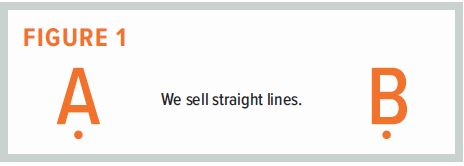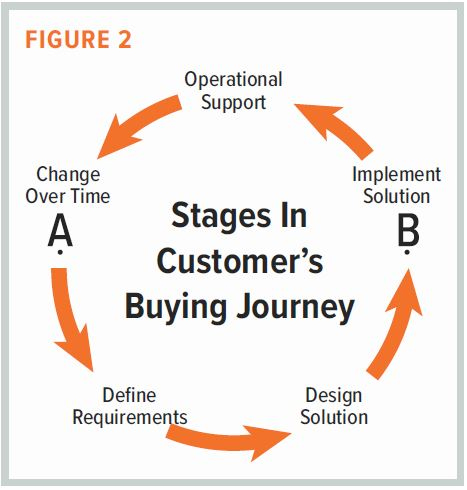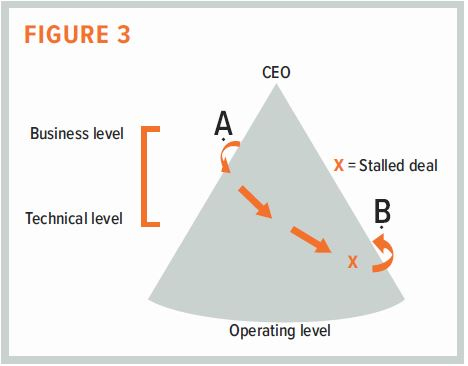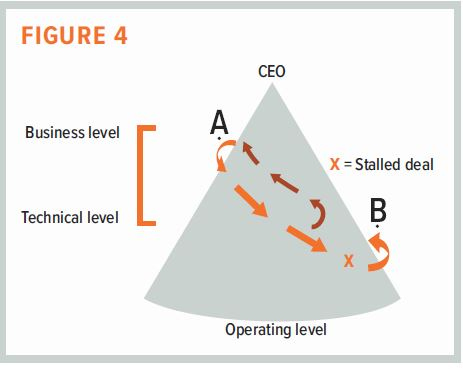Selling From A To B: The Shortest Distance Between "Problem" And "Solved"
By Richard Chambers
 An A-to-Z library of dozens of sales books isn’t required reading, because I’ve found that my students don’t need encyclopedic knowledge. They need a mental map to lead the customer from Point A — the customer’s current frustrating condition — to Point B — the customer’s desired business outcome. Lewis Carroll once observed that if you don’t know where you’re going, any road will take you there. My corollary: If you know where you are in the buyer’s journey, you will know exactly what to do next. The measure of how well your distributors and vendors assist you in moving along the journey is channel value.
An A-to-Z library of dozens of sales books isn’t required reading, because I’ve found that my students don’t need encyclopedic knowledge. They need a mental map to lead the customer from Point A — the customer’s current frustrating condition — to Point B — the customer’s desired business outcome. Lewis Carroll once observed that if you don’t know where you’re going, any road will take you there. My corollary: If you know where you are in the buyer’s journey, you will know exactly what to do next. The measure of how well your distributors and vendors assist you in moving along the journey is channel value.
One full-page ad in the Wall Street Journal claimed, “We sell straight lines,” and showed two large dots above the headline labeled points “A” and “B”. Though clever, the graphic struck me as simplistic. For years I had used those same labels to depict getting a customer from “problem” (Point A) to “solved” (Point B). But you can’t simply impose a straight edge on the process. You must lead your customer along a circuitous journey that involves distinct decision-making stages and engages a cast whose roles you ignore at your peril. So I was not surprised to discover later that the company boasting of its shortcuts in the ad was the accounting firm who brought us the Enron disaster, then the largest corporate failure in U.S. history.
If the shortest distance from A to B is bound to be roundabout, how do you keep your solution sales process simple enough to have a mental map, yet robust enough to accommodate the stages and roles of a channel sale? Keep reading for an optimal way to account for nuance while keeping sales simple. Will your business solution be hybrid cloud IT for a law firm, a POS cash system for a retailer, remote monitoring for a college, or secure mobility for a healthcare clinic? Insert your own technology in our scenarios.


![]()
"My students don’t need encyclopedic knowledge. They need a mental map to lead the customer from Point A — the customer’s current frustrating condition — to Point B — the customer’s desired business outcome."
THE SHORTEST DISTANCE IS NOT A STRAIGHT LINE
Figure 2 illustrates the cycle representing the customer’s journey to a goal (get to Point B) or to relieve a pain (get off Point A). In our process, a customer’s journey mirrors the same stages their internal project managers might assign in a traditional plan-design-implement- manage model. Further, the cycle graphic reminds us of the change a customer faces even after the buying journey ends. Let’s review the stages.
- Define Requirements. This is a head-scratching phase with plans first discussed to fix some trouble. Their competitors may offer a better customer experience. Network users complain about applications. They weathered a recent security breach. Staff search for guidance and hit your landing page.
- Design Solution. With a clearer sense of a problem, the end user looks for the best course of action to bring relief. Solutions providers could be whiteboarding some options or providing demo units for a proof of concept.
- Implement Solution. Once the customer reaches consensus on how to proceed, it solicits proposals. Many resellers mistake quote requests to be bona fide signals of readiness to buy. In fact, a budgeting proposal could have been sought at either of the preceding stages with no timeline yet.
- Provide Operational Support. The end user, delivered to Point B, is now engaged in the training, refinements, and performance as planned.
- Change happens over time … arrive at a new Point A. Whether new technology attracts them, business environments shift, or their own growth creates strife, customers begin a new journey.

WHO’S THERE?
Figure 2 above is not meant to imply a flat, two-dimensional plane. The end-user roles are arranged in 3-D as an initiative rotates through the stages. Figure 3’s cone icon represents the end-user organization chart, with the CEO at the top, the Line of Business managers just below, a middle ground of technical and purchasing contacts, and a base of users. As the customer progresses from one stage to the next, the principal contact point tends to get delegated lower in the company. While oversight from above will occur, a share of decision-making authority gets fractioned out along the way.
A long-term customer, especially one with whom you engage with managed services, will likely invite you in early at the top. I want to focus my guidance on new customers where your entry point is somewhere mid-rotation in the buying journey, with a midlevel contact to whom you are a stranger. While hunting for “new logos,” you generate dozens of calls and mostly reach voicemail with no return calls. Frustrated, you treat any live conversation with eagerness. You spend a couple hours preparing a quote and log an opportunity in CRM, with a next step to follow up and close the sale. However, you make repeated calls for updates, and you get delays or no response. The deal is stalled at the “X” in Figure 3.
WHERE AM I?
When opportunities are not moving forward, you may not know what to do. Any of a dozen options seem as good as the others, and the more wrong turns you make, the greater the mileage you must cover in guiding the customer from A to B. In my pipeline reviews of reps’ stalled deals, the most frequent explanation for the halt is not uncompetitive pricing, but perceived risk. The buyer is uncertain that the proposal will satisfy financial, technical, or user experience requirements. Neither the rep nor the midlevel technical contact has sufficient grasp of the business implications of Point B to confirm or redirect the pursuit. This is evidence that the customer is either still at the Design Solution stage, without an unequivocal mandate or, earlier still, at Define Requirements, where the outcomes are not yet clearly visualized. Consider these recent stalled deals:

- A retail chain’s guest Wi-Fi service was being upgraded to achieve the Marketing VP’s initiative to harvest user data from mobile devices, but IT lacked the manpower budget for support.
- A digital signage program in a hospital was blocked by the Operations VP because the wayfinding signage was out of compliance with ADA specs.
- A data center refresh had been postponed for six months by IT until next year’s capital expense budget was refreshed, but the Finance VP was open to remote management services charged to his operating expenses budget.
Had your conversation started with these business managers, you would have been alerted to find a path around these hurdles. Instead, when encountering an opportunity midstream, you must take pains to validate your position in that buyer’s journey before proposing a bill of materials or set of services, no matter how eager you are to proceed. My favorite probe: ”Help me understand the business requirements underlying the configuration you’re asking for.” If your contact cannot tell you, you have a choice: Proceed with a low likelihood of converting your quote to a sale, or ratchet the process back to an earlier stage. The latter will flush out the problems to be solved, the people feeling the pain, and the purse strings in hand to create relief.
WHEN YOU KNOW WHERE YOU ARE, YOU’LL KNOW WHAT TO DO NEXT
Figure 4 shows that simple idea of ratcheting the process back. Like when a jar lid’s rotation guides the lid up or down, your intervention to temporarily reverse their process brings you higher in the organization, where your senior contacts will redirect the downward and better-aimed forward course toward Point B. This tactic to overcome stalls has moved more hardware, secured more managed services contracts, and renewed more licenses than any other advice I give my clients. This technique isn’t just an excuse to “go over someone’s head” when trying to close a deal. The customer sees you are engaged in a process to get them from A to B using the custom details of their own journey map.
One challenge might be your lack of the vertical industry lingo to discuss Point A and the accompanying costs of their being stuck. Or you may not know how to convey the outcomes of your services in terms of the company’s P&L statement. In other words, you can’t talk about The Good (Point B), The Bad (Point A), and The Money (the financial implications of each). Who do you turn to if you and your team feel deficient in confidence and expertise?
HOW YOUR CHANNEL CAN HELP YOU
Here are ways that your channel colleagues can assist your effort.
Vendors
- Vendors provide “BANT”-qualified leads to channel partners. The leads are underappreciated because they are rarely low-hanging fruit. But they are a far better alternative to a couple dozen cold calls. So, nurture those leads, and you will be rewarded with more. Some tips:
- B — Budget. Pursue money not simply as a CapEx, OpEx, or budget issue. Calculate the financial impact of staying at Point A and of getting to Point B. Position your reward as a small share of the value to be created.
- A — Authority. What role do the contacts play in the customer’s journey? Be ready to ratchet back and up.
- N — Need. Define the business level Point A and Point B, not just the technical.
- T — Timing. If at an early stage, sell your advice.
- Use a vendor’s partner portal for certification and insight on vertical solutions to become a technology expert in an industry.
- Enlist support from a vendor field rep for a joint call with an end-user executive, discussing with the rep your location in that customer’s journey.
Distributors
- Vendor-funded subject matter experts can be your best friend. Whether schooled in servers, licensing, cloud platforms, or endpoint devices, they know how total solutions are formed and know the questions that will locate you for the best next step.
- If a new strategic solution area is being considered, engage a senior distribution marketing or sales leader for a visioning con call with your end user.
- Seek out distributor assessment tools for site surveys, print management, storage usage, network penetration, or other resources to provide insight at the Define Requirements stage.
When it all seems too complex, take a breath and remember Zig Ziglar’s advice that you can get whatever you want in life if you help enough other people get what they want. Selling from A to B keeps you on track to deliver others to their destination. Do so in enough volume, and you will arrive at your own Point B.

